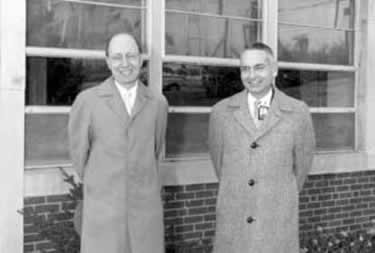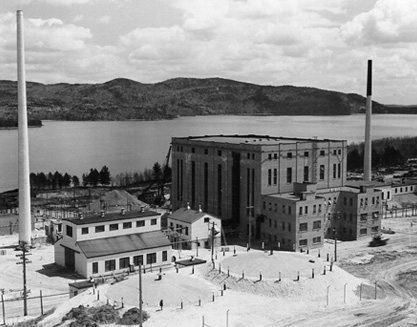|
George Weil
George Leon Weil (September 18, 1907 – July 1, 1995) was an American physicist. On December 2, 1942, he removed the control rod from the Chicago Pile-1 nuclear reactor, initiating the first man-made, self-sustaining nuclear chain reaction. Early life George Leon Weil was born in New York City on September 18, 1907, the son of Leon and Elsie Rose Weil. His great-grandfather was Henry Lehman (1822–1855), founder of H. Lehman, which became Lehman Brothers. He had an older sister, Helen. He entered Harvard College, from which he graduated in 1939 and then Columbia University, where he earned his master's degree, and later his doctorate, writing his 1942 doctoral thesis on ''Beta-Ray Spectra of Arsenic, Rubidium and Krypton''. It was subsequently published in the Physical Review in September 1942. Manhattan Project At Columbia University, Weil became involved in Enrico Fermi's efforts to build a nuclear reactor. In December 1941, the Office of Scientific Research and Development ... [...More Info...] [...Related Items...] OR: [Wikipedia] [Google] [Baidu] |
New York City
New York, often called New York City or NYC, is the List of United States cities by population, most populous city in the United States. With a 2020 population of 8,804,190 distributed over , New York City is also the List of United States cities by population density, most densely populated major city in the United States, and is more than twice as populous as second-place Los Angeles. New York City lies at the southern tip of New York (state), New York State, and constitutes the geographical and demographic center of both the Northeast megalopolis and the New York metropolitan area, the largest metropolitan area in the world by urban area, urban landmass. With over 20.1 million people in its metropolitan statistical area and 23.5 million in its combined statistical area as of 2020, New York is one of the world's most populous Megacity, megacities, and over 58 million people live within of the city. New York City is a global city, global Culture of New ... [...More Info...] [...Related Items...] OR: [Wikipedia] [Google] [Baidu] |
Physical Review
''Physical Review'' is a peer-reviewed scientific journal established in 1893 by Edward Nichols. It publishes original research as well as scientific and literature reviews on all aspects of physics. It is published by the American Physical Society (APS). The journal is in its third series, and is split in several sub-journals each covering a particular field of physics. It has a sister journal, ''Physical Review Letters'', which publishes shorter articles of broader interest. History ''Physical Review'' commenced publication in July 1893, organized by Cornell University professor Edward Nichols and helped by the new president of Cornell, J. Gould Schurman. The journal was managed and edited at Cornell in upstate New York from 1893 to 1913 by Nichols, Ernest Merritt, and Frederick Bedell. The 33 volumes published during this time constitute ''Physical Review Series I''. The American Physical Society (APS), founded in 1899, took over its publication in 1913 and star ... [...More Info...] [...Related Items...] OR: [Wikipedia] [Google] [Baidu] |
Alvin Weinberg
Alvin Martin Weinberg (; April 20, 1915 – October 18, 2006) was an American nuclear physicist who was the administrator at Oak Ridge National Laboratory (ORNL) during and after the Manhattan Project. He came to Oak Ridge, Tennessee, in 1945 and remained there until his death in 2006. He was the first to use the term "Faustian bargain" to describe nuclear energy. A graduate of the University of Chicago, which awarded him his doctorate in mathematical biophysics in 1939, Weinberg joined the Manhattan Project's Metallurgical Laboratory in September 1941. The following year he became part of Eugene Wigner's Theoretical Group, whose task was to design the nuclear reactors that would convert uranium into plutonium. Weinberg replaced Wigner as director of research at ORNL in 1948, and became director of the laboratory in 1955. Under his direction it worked on the Aircraft Nuclear Propulsion program, and pioneered many innovative reactor designs, including the pressurized water ... [...More Info...] [...Related Items...] OR: [Wikipedia] [Google] [Baidu] |
Chalk River Laboratories
Chalk River Laboratories (french: Laboratoires de Chalk River; also known as CRL, Chalk River Labs and formerly Chalk River Nuclear Laboratories, CRNL) is a Canadian nuclear research facility in Deep River, about north-west of Ottawa. CRL is a site of major research and development to support and advance nuclear technology, particularly CANDU reactor technology. CRL has expertise in physics, metallurgy, chemistry, biology, and engineering, and hosts unique research facilities. For example, Bertram Brockhouse, a professor at McMaster University, received the 1994 Nobel Prize in Physics for his pioneering work in neutron spectroscopy while at CRL from 1950 to 1962. Sir John Cockcroft was an early director of CRL and also a Nobel laureate. Until the shutdown of its nuclear reactor in 2018, CRL produced a large share of the world's supply of medical radioisotopes. It is owned by the Canadian Nuclear Laboratories subsidiary of Atomic Energy of Canada Limited and operated under con ... [...More Info...] [...Related Items...] OR: [Wikipedia] [Google] [Baidu] |
Trinity Nuclear Test
Trinity was the code name of the first detonation of a nuclear weapon. It was conducted by the United States Army at 5:29 a.m. on July 16, 1945, as part of the Manhattan Project. The test was conducted in the Jornada del Muerto desert about southeast of Socorro, New Mexico, on what was then the USAAF Alamogordo Bombing and Gunnery Range, now part of White Sands Missile Range. The only structures originally in the vicinity were the McDonald Ranch House and its ancillary buildings, which scientists used as a laboratory for testing bomb components. A base camp was constructed, and there were 425 people present on the weekend of the test. The code name "Trinity" was assigned by J. Robert Oppenheimer, the director of the Los Alamos Laboratory, inspired by the poetry of John Donne. The test was of an implosion-design plutonium device, informally nicknamed "The Gadget", of the same design as the Fat Man bomb later detonated over Nagasaki, Japan, on August 9, 1945. The complexi ... [...More Info...] [...Related Items...] OR: [Wikipedia] [Google] [Baidu] |



